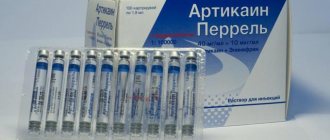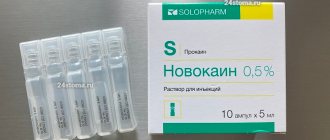Ropivacaine Kabi, 10 mg/ml, solution for injection, 10 ml, 5 pcs.
Ropivacaine Kabi should only be administered by specialists with sufficient experience in administering local anesthesia or under their supervision, with equipment and medications available for resuscitation.
Solution for injection, 5 mg/ml
For perineural administration (spinal and conduction anesthesia)
IV catheters should be installed before large blockades can be performed.
Ropivacaine Kabi is administered slowly or by increasing sequential doses of the drug at a rate of 25–50 mg/min.
To prevent the anesthetic from entering the vessel, an aspiration test must be performed before and during the administration of the drug. Accidental intravascular injection is recognized by a temporary increase in heart rate.
The following table provides dosage guidelines for intrathecal blockade, acute pain relief, and peripheral nerve blockade. The minimum dosage sufficient to produce an effective blockade should be used. When deciding on a dose, the experience of the clinical specialist and knowledge of the patient's physical condition are important.
Recommendations for dosing of the drug Ropivacaine Kabi for adults and children over 12 years of age
(see table 2)
table 2
| Indications | Drug concentration, mg/ml | Volume of solution, ml | Dose, mg | Onset of action, min | Duration of action, h |
| Intrathecal block; surgical interventions | 5 | 3–5 | 15–25 | 1–5 | 2–6 |
Recommendations for dosing of the drug Ropivacaine Kabi for children from 1 year to 12 years
(see table 3)
Table 3
| Indications | Drug concentration, mg/ml | Volume of solution, mg/kg | Dose, mg |
| Relief of acute pain syndrome (intraoperative and postoperative); block of peripheral nerves, such as the ilioinguinal nerve | 5 | 0,5–0,6 | 2,5–3 |
The doses indicated in the table are considered sufficient to achieve a reliable blockade and are indicative when using the drug in adults, because There is individual variability in the speed of development of the block and its duration.
The intrathecal route of administration of ropivacaine hydrochloride has not been studied for anesthesia for caesarean section.
There are individual differences in the onset of the blockade and its duration.
The values in the Dose column reflect the expected average range of dosages required. To obtain information about the factors influencing the blockade technique and the individual characteristics of patients, you should refer to standard manuals.
Due to the lack of sufficient clinical observations, it is not recommended to use Ropivacaine Kabi in children under 1 year of age.
Solution for injection, 2 mg/ml, 7.5 mg/ml, 10 mg/ml
For epidural and perineural administration (conduction and infiltration anesthesia and analgesia)
Adults and children over 12 years old.
In general, anesthesia for surgical interventions requires higher doses and more concentrated solutions of the drug than when using an anesthetic for pain relief. For analgesia (eg, epidural administration to suppress acute pain), lower concentrations and doses are recommended and a dose of 2 mg/mL is generally recommended. For intra-articular administration, a dose of 7.5 mg/ml is recommended. Ropivacaine Kabi 10 mg/ml is recommended for epidural anesthesia when complete motor blockade is necessary for surgery.
The following tables provide dosage guidelines for more commonly used blocks. The minimum dosage sufficient to produce an effective blockade should be used. When deciding on a dose, the experience of the clinical specialist and knowledge of the patient's physical condition are important.
Recommendations for dosing of the drug Ropivacaine Kabi for adults and children over 12 years of age
(see table 4)
The dosages given in Table 4 are considered sufficient for successful blockade and should serve as a guide for use in adult patients, because There are individual deviations in the timing of the blockade and its duration. The values in the Dose column reflect the expected range of average doses required.
Table 4
| Indications | Drug concentration, mg/ml | Volume of solution, ml | Dose, mg | Onset of action, min | Duration of action, h |
| Anesthesia for surgical interventions | |||||
| Epidural anesthesia at the lumbar level | |||||
| Surgical interventions | 7,5 | 15–25 | 113–188 | 10–20 | 3–5 |
| 10 | 15–20 | 150–200 | 10–20 | 4–6 | |
| C-section | 7,5 | 15–20 | 113–1504 | 10–20 | 3–5 |
| Epidural anesthesia at the thoracic level | |||||
| Postoperative analgesic blockade and surgical interventions | 7,5 | 5–15 | 38–113 | 10–20 | — |
| Blockade of major nerve plexuses | |||||
| For example, brachial plexus block1 | 7,5 | 30–40 | 225–300 | 10–25 | 6–10 |
| Conduction and infiltration anesthesia | 7,5 | 1–30 | 7,5–225 | 1–15 | 2–6 |
| Relief of acute pain syndrome | |||||
| Epidural injection at the lumbar level | |||||
| Bolus | 2 | 10–20 | 20–40 | 10–15 | 0,5–1,5 |
| Periodic administration (for example, for pain relief during labor) | 2 | 10–15 (minimum interval 30 minutes) | 20–30 | — | — |
| Extended infusion for | |||||
| - labor pain relief | 2 | 6–10 ml/h | 12–20 mg/h | — | — |
| — postoperative pain relief | 2 | 6–14 ml/h | 12–28 mg/h | — | — |
| Peripheral nerve block | |||||
| For example, femoral nerve block or interscalene block (extended infusions or repeated injections) | 2 | 5–10 ml/h | 10–20 mg/h | — | — |
| Epidural injection at the thoracic level | |||||
| Extended infusion (eg for postoperative pain relief) | 2 | 6–14 ml/h | 12–28 mg/h | — | — |
| Conductor blockade and infiltration anesthesia | 2 | 1–100 | 2–200 | 1–5 | 2–6 |
| Intra-articular injection | |||||
| Knee arthroscopy2 | 7,5 | 20 | 1503 | — | 2–6 |
1 The dosage for regional anesthesia should be adjusted according to the site of application and the patient's condition. Scalene and supraclavicular brachial plexus blocks may result in a higher incidence of adverse reactions, regardless of the local anesthetic used.
2 Cases of chondrolysis have been reported with postoperative extended intra-articular infusion of local anesthetics. Ropivacaine Kabi should not be used for long-term intra-articular administration.
3 If Ropivacaine Kabi was additionally used for other types of anesthesia, the maximum dose should not exceed 225 mg.
4 Stepped dosing should be used, with an initial dose of approximately 100 mg (97.55 mg = 13 mL, 105 mg = 14 mL) administered over 3–5 min. Two additional doses, totaling an additional 50 mg, may be administered as needed.
Standard guidelines should be used to understand the factors influencing the method of performing individual blocks and the requirements for specific patient groups.
To prevent the anesthetic from entering the vascular bed, it is imperative to carry out an aspiration test before and during the administration of the drug. If it is necessary to administer a large dose of the drug, it is recommended to administer a test dose of 3–5 ml of lidocaine with epinephrine. Accidental intravascular injection is recognized by a temporary increase in heart rate, and accidental intrathecal injection is recognized by signs of spinal block. If toxic symptoms occur, administration of the drug should be stopped immediately.
Aspiration should be performed before and during administration of the main dose, which should be administered slowly or stepwise at a level of 25–50 mg/min, while closely monitoring the patient's vital signs and maintaining verbal contact with the patient.
A single dose of Ropivacaine Kabi for epidural blockade for surgery at a dose of up to 250 mg is usually well tolerated by patients.
When brachial plexus block is used with 40 ml of Ropivacaine Kabi 7.5 mg/ml, maximum plasma concentrations of ropivacaine hydrochloride in some patients can reach values characterized by mild symptoms of CNS toxicity. Therefore, the use of a dose higher than 40 ml of Ropivacaine Kabi 7.5 mg/ml (300 mg ropivacaine hydrochloride) is not recommended.
When using long-term blockade, either by continuous infusion or repeated bolus administration, the risks of achieving toxic plasma concentrations or causing local nerve damage must be taken into account. Administration of ropivacaine hydrochloride over 24 hours at a dose of up to 800 mg in total during surgical interventions and for postoperative pain relief, as well as prolonged epidural infusion after surgery at a rate of up to 28 mg/h for 72 hours, is well tolerated by adult patients.
To relieve postoperative pain, the following method is recommended: if an epidural catheter was not installed during surgery, after its installation, an epidural blockade is performed with a bolus injection of the drug Ropivacaine Kabi 7.5 mg/ml. Analgesia is maintained by infusion of the drug Ropivacaine Kabi 2 mg/ml. In most cases, for the management of moderate to severe postoperative pain, infusion at a rate of 6–14 ml/h (12–28 mg/h) provides adequate analgesia with minimal non-progressive motor blockade (a significant reduction in the need for opioid analgesics has been observed using this technique ). For postoperative pain relief, Ropivacaine Kabi 2 mg/mL can be administered continuously as an epidural infusion over 72 hours without or in combination with fentanyl (1–4 mcg/mL). Ropivacaine Kabi 2 mg/ml (6–14 ml/hour) provided adequate pain relief in most patients. The combination of the drug Ropivacaine Kabi and fentanyl led to improved pain relief, while causing side effects inherent in narcotic analgesics.
The use of Ropivacaine Kabi concentrations greater than 7.5 mg/ml during caesarean section has not been studied.
Kidney failure
As a rule, when administering a single dose or short-term therapy to patients with impaired renal function, no dose adjustment is required.
Liver failure
Ropivacaine is metabolized in the liver and, as a result, should be used with caution in patients with serious liver disease. Repeated doses may need to be reduced due to delayed elimination.
Patients suffering from hypovolemia
Patients who are hypovolemic for any reason may develop acute and severe hypotension during epidural anesthesia, regardless of the use of local anesthetic.
Recommendations for dosing of the drug Ropivacaine Kabi for children from 0 to 12 years
(see table 5)
Table 5
| Indications | Concentration, mg/ml | Volume, mg/kg | Dose, mg/kg |
| Relief of acute syndrome (pre- and postoperative pain relief) | |||
| Caudal epidural insertion | 2 | 1 | 2 |
| Blockades below T12, in children up to 25 kg | |||
| Extended epidural infusion in children up to 25 kg | |||
| Age from 0 to 6 months | |||
| Bolus 1 | 2 | 0,5–1 | 1–2 |
| Infusion up to 72 hours | 2 | 0.1 ml/kg/h | 0.2 ml/kg/h |
| Age from 6 to 12 months | |||
| Bolus 1 | 2 | 0,5–1 | 1–2 |
| Infusion up to 72 hours | 2 | 0.2 ml/kg/h | 0.4 ml/kg/h |
| Age from 1 to 12 years inclusive | |||
| Bolus 2 | 2 | 1 | 2 |
| Infusion up to 72 hours | 2 | 0.2 ml/kg/h | 0.4 ml/kg/h |
1 Lower doses of the suggested dosing range are recommended for thoracic and epidural blocks, whereas larger doses are recommended for lumbar and caudal epidural blocks.
2 Recommended for lumbar epidural blocks. It is reasonable to reduce the bolus dose in case of analgesia at the thoracic level.
The dosages in Table 5 should be considered a guide to the use of the drug in pediatric practice. At the same time, there is individual variability in the speed of development of the block and its duration. In children with increased body weight, a gradual reduction in the dose of the drug is often required, and the patient's ideal body weight should be taken as a basis. For factors influencing specific block techniques and individual patient requirements, the data provided in standard guidelines must be taken into account. The volume for a single caudal block and the volume for epidural bolus dosages should not exceed 25 mL in any patient.
Careful aspiration is recommended before and during injection to prevent intravascular injection. During the administration of the drug, it is necessary to carefully monitor the patient's vital functions. If toxic symptoms occur, the infusion should be stopped immediately. A single caudal epidural injection of ropivacaine hydrochloride at a dose of 2 mg/ml (at a rate of 2 mg/kg, solution volume 1 ml/kg) produces adequate postoperative analgesia below the T12 level in most patients.
Children over 4 years of age tolerate doses of 3 mg/kg well. The volume of epidural solution administered at the caudal level can be varied to achieve varying degrees of sensory block, as described in specialized guidelines.
Regardless of the type of anesthesia, bolus administration of the calculated dose of the drug is recommended.
The use of the drug at concentrations above 5 mg/ml, as well as the intrathecal use of Ropivacaine Kabi, have not been studied in children.
Regardless of route of administration, ropivacaine hydrochloride has not been studied in premature infants.
Instructions for use of solution for injection 2 mg/ml, 5 mg/ml, 7.5 mg/ml, 10 mg/ml
The solution does not contain preservatives and is intended for single use only.
To be used immediately after opening the Friflex® ampoule or bag; the unused remainder of the drug is destroyed.
Before use, the medicinal product must be carefully examined.
The injection solution is only suitable if it is transparent, there are no visible mechanical particles, and the container is not damaged.
Any amount of solution remaining in the ampoule or container after use must be destroyed.
An unopened ampoule or container of solution should not be autoclaved.
Unopened blister packs provide sterility to the outer surface of the ampoule or container and are preferred for use in environments requiring sterility.
Ropivacaine Kabi solution for injection 10 mg/ml 10 ml No. 5
Action
A long-acting amide-type local anesthetic that is a pure enantiomer.
It has both anesthetic and analgesic effects. By reversibly blocking voltage-gated Na+ channels, it prevents the generation of impulses in the endings of sensory nerves and the conduction of impulses along nerve fibers. High concentrations of the drug are used for local anesthesia during surgical interventions. Getting into the systemic bloodstream in low concentrations, it can cause sensory block (analgesia) with minimal and non-progressive motor block, getting in excess quantities, has a depressant effect on the central nervous system and myocardium (reduces its excitability, automaticity and conductivity). Epinephrine has virtually no effect on the duration and intensity of the blockade caused by ropivacaine. Signs of toxicity from the central nervous system precede signs of toxicity from the cardiovascular system, because observed at lower plasma concentrations of the drug. Ropivacaine has a wide therapeutic range (the range between doses that produce therapeutic and toxic effects). In vivo animal studies have shown that ropivacaine has less myocardial toxicity compared to bupivacaine. Indirect cardiovascular effects (hypotension, bradycardia) may occur after epidural administration of ropivacaine and are due to the resulting sympathetic blockade.
The onset and duration of anesthesia with Ropivacaine Kabi depend on the concentration and site of administration of the drug.
Pharmacokinetics
The concentration of ropivacaine in plasma depends on the dose, route of administration and the degree of vascularization of the injection site. Pharmacokinetics is linear, Cmax is proportional to the administered dose. After epidural administration, ropivacaine is completely absorbed into the blood. Absorption is biphasic, T1/2 for each phase is 14 minutes and 4 hours, respectively. The slowdown in the elimination of ropivacaine is determined by slow absorption, which explains the longer T1/2 after epidural administration compared to intravenous administration. The total plasma clearance of ropivacaine is 440 ml/min, plasma clearance of unbound substance is 8 l/min, renal clearance is 1 ml/min, Vd at steady state is 47 l, hepatic extraction rate is about 0.4, T1/2 is 1.8 hours. Ropivacaine intensively binds to plasma proteins (mainly alpha1-acid glycoproteins), the unbound fraction of ropivacaine is about 6%. Long-term epidural administration of ropivacaine after surgery leads to an increase in the concentration of the drug in plasma, which is due to an increase in the concentration of acidic glycoproteins in the blood, while the concentration of the unbound, pharmacologically active form of ropivacaine in plasma changes to a much lesser extent than the total concentration of ropivacaine.
Ropivacaine penetrates well through the placental barrier with rapid achievement of equilibrium in the unbound fraction. Plasma protein binding is less in the fetus than in the mother, resulting in lower drug concentrations in fetal plasma compared to total drug concentrations in maternal plasma. Ropivacaine is extensively metabolized in the body, mainly through aromatic hydroxylation. Major metabolites: 3-hydroxyropivacaine: 4-hydroxyropivacaine, N-dealkylated metabolites and 4-hydroxydealkylated ropivacaine, 3-hydroxyropivacaine (conjugated and unconjugated) found in plasma 3-hydroxy- and 4-hydroxyropivacaine have a weaker local anesthetic effect compared to ropivacaine. After intravenous administration, 86% of ropivacaine is excreted in the urine (only 1% unchanged). About 37% of 3-hydroxyropivacaine, the main metabolite of ropivacaine, is excreted in the urine (mainly in conjugated form).
1-3% of ropivacaine is excreted in the urine in the form of metabolites: 4-hydroxyropivacaine N-dealkylated metabolites and 4-hydroxydealkylated ropivacaine. There is no evidence of racemization of ropivacaine in vivo.



